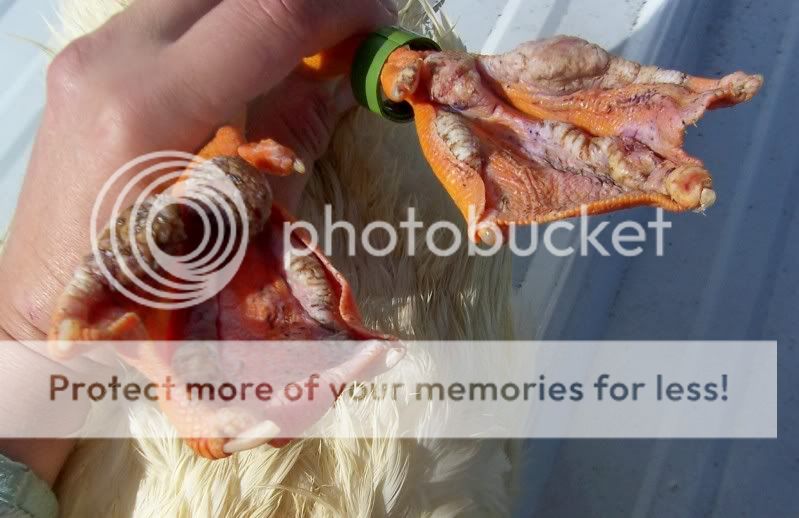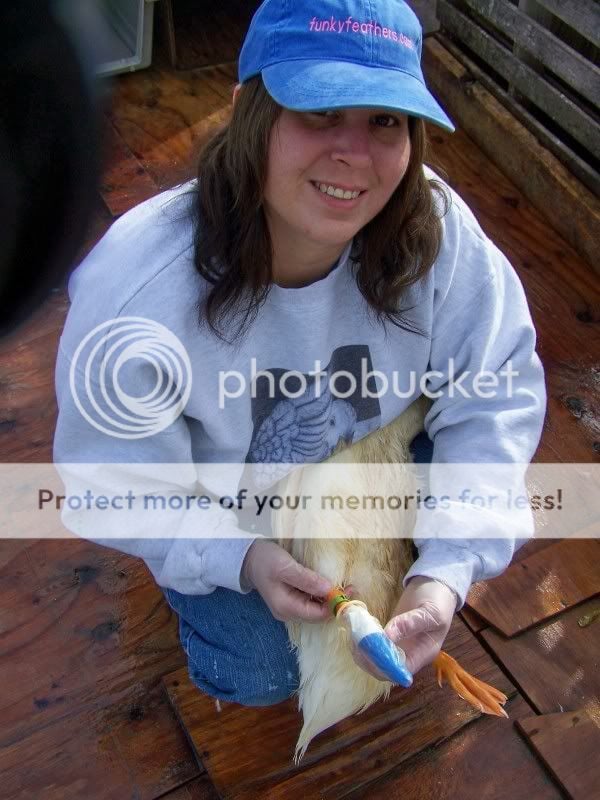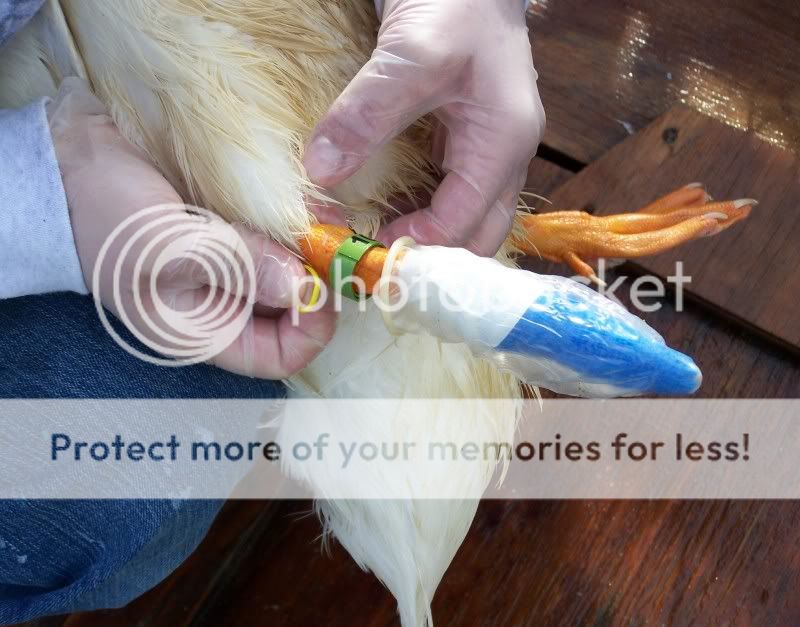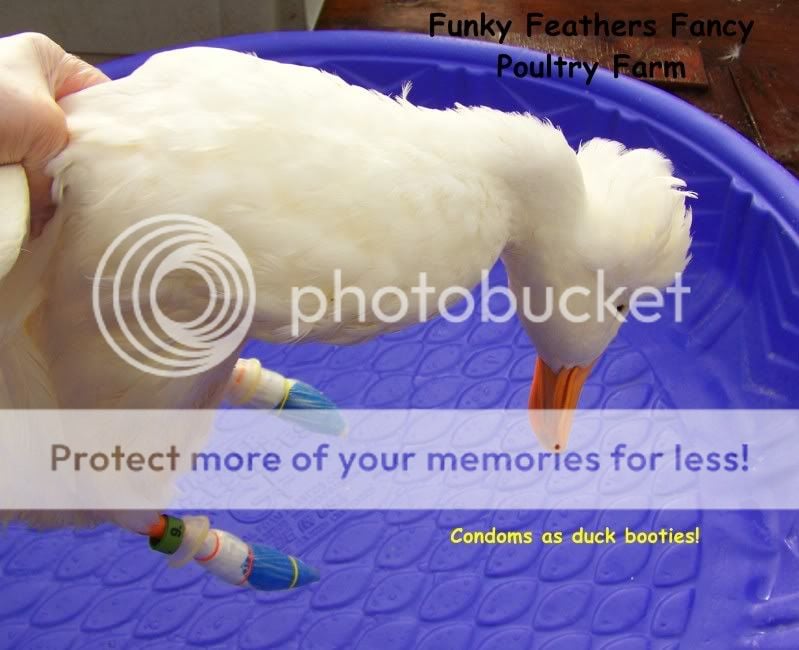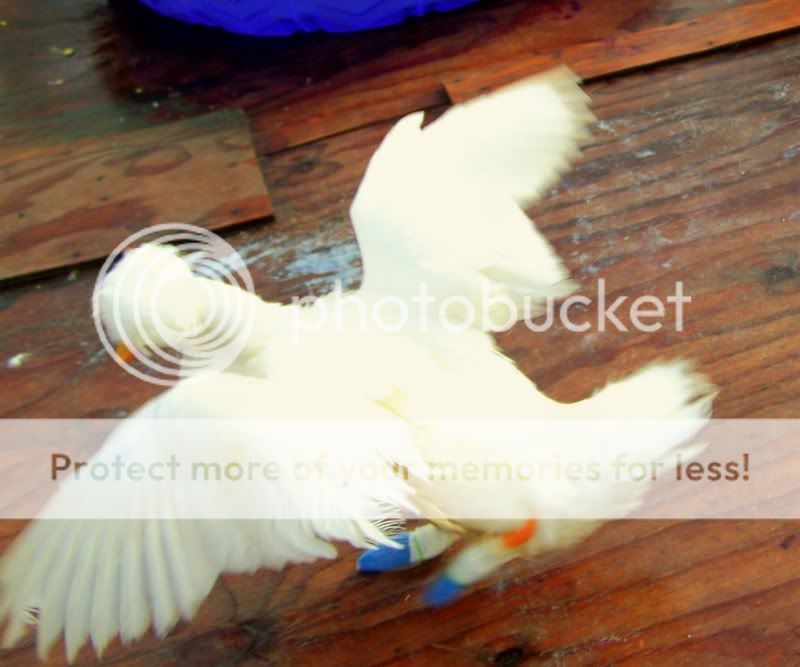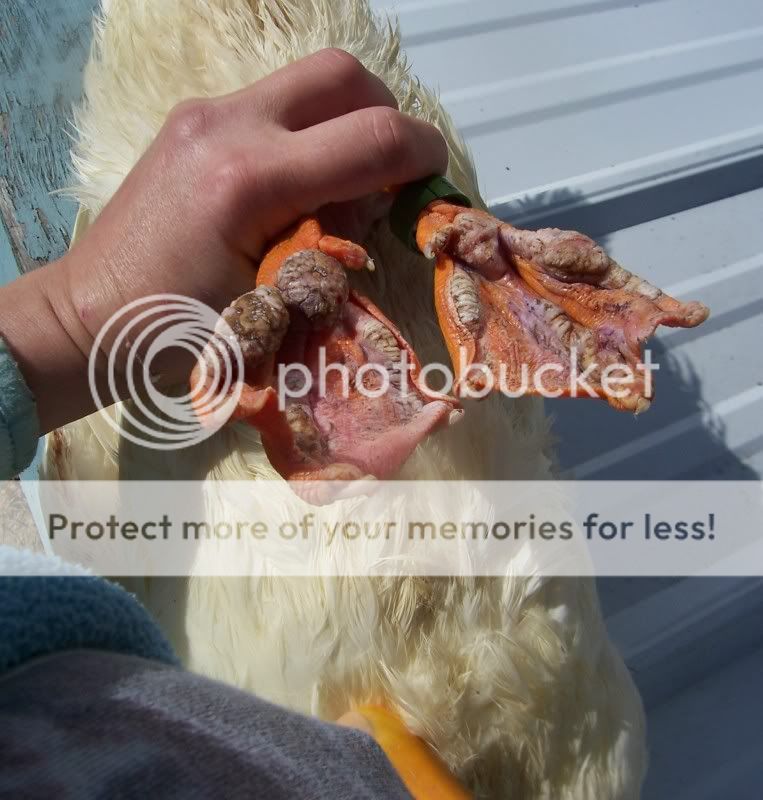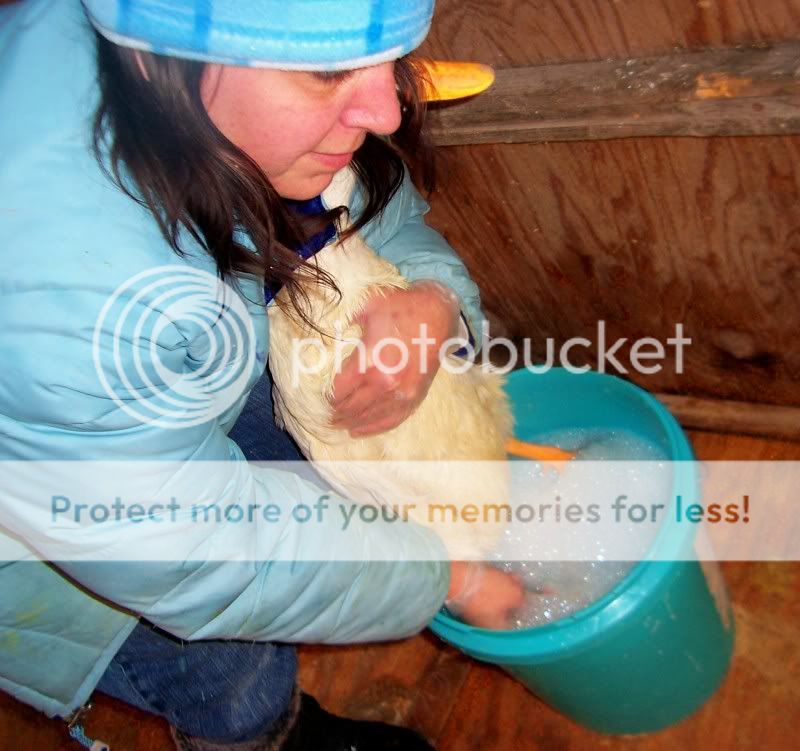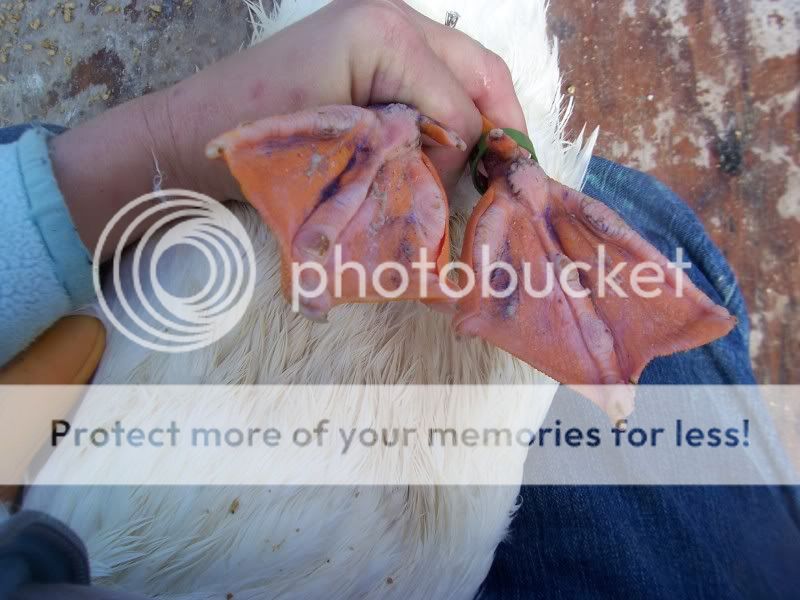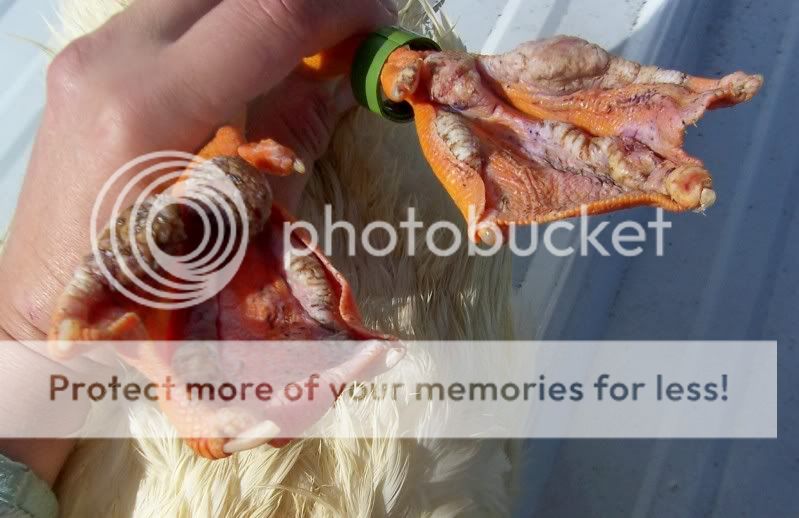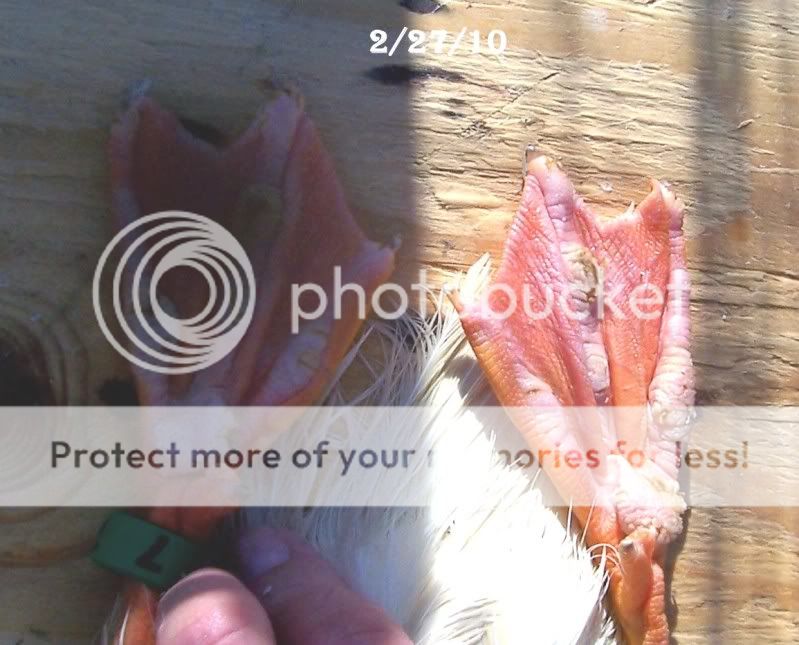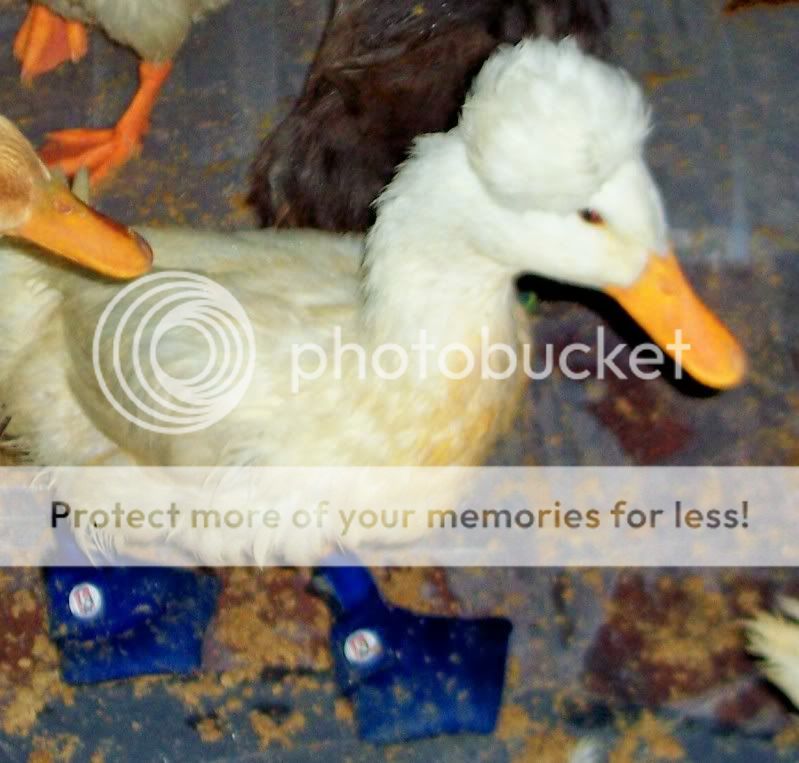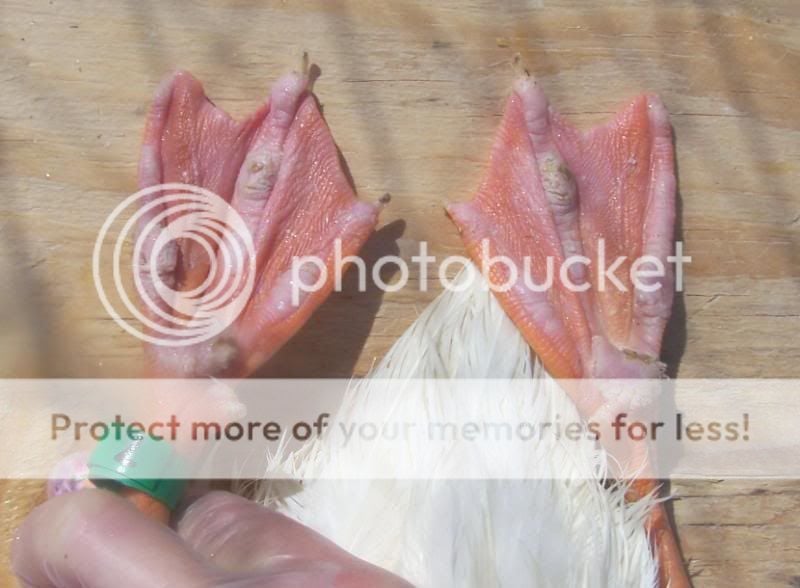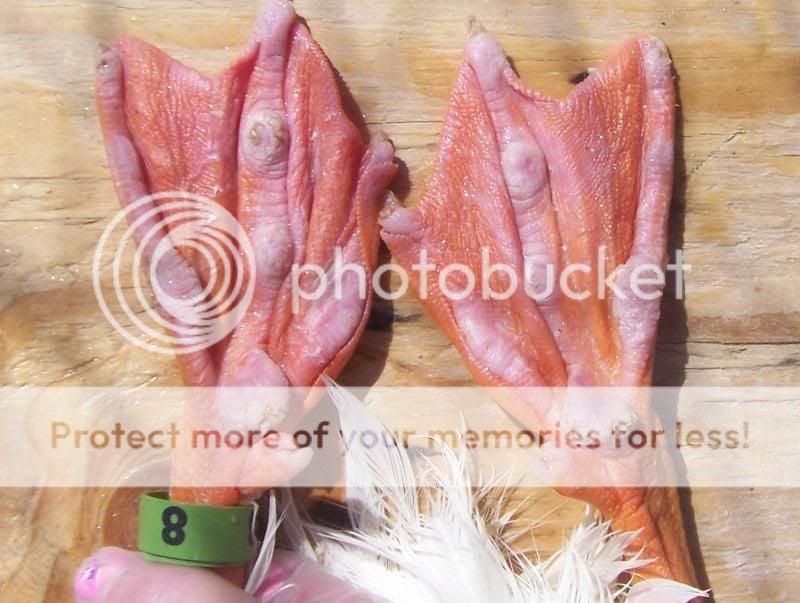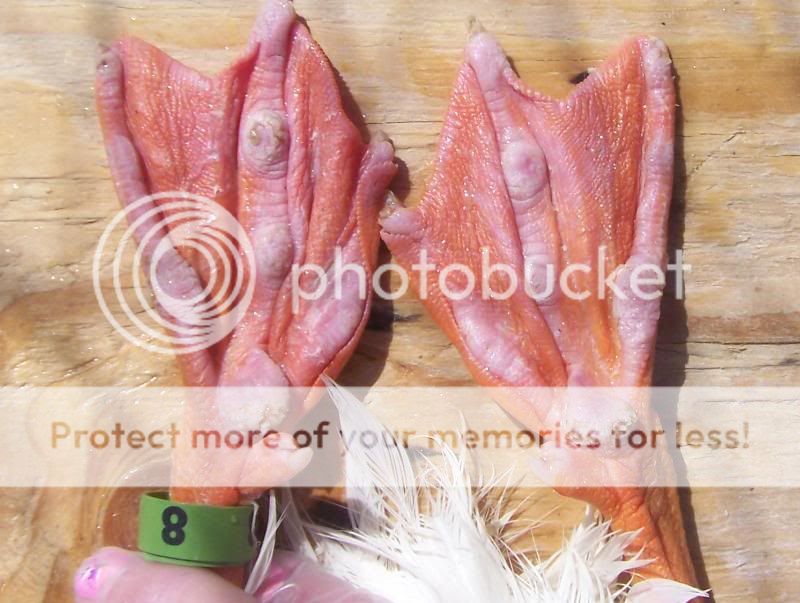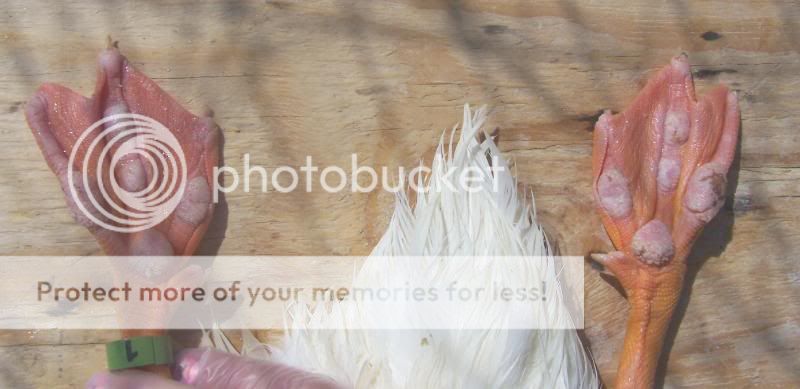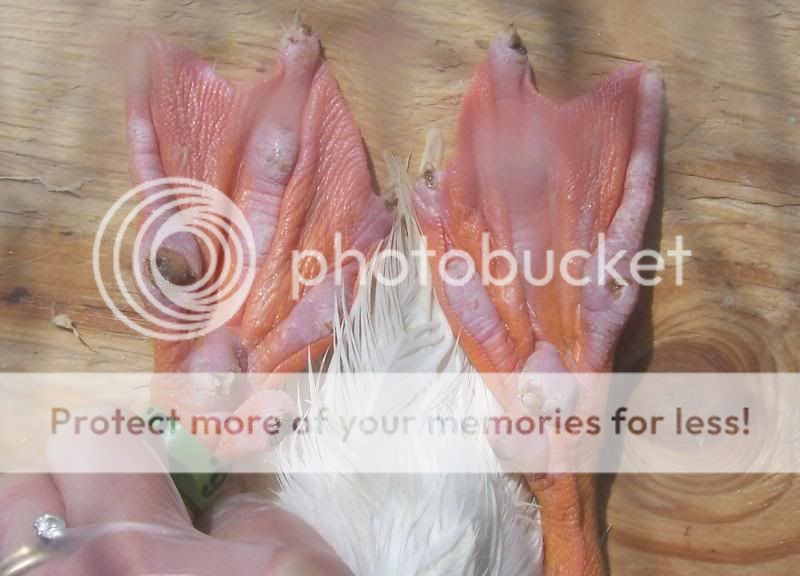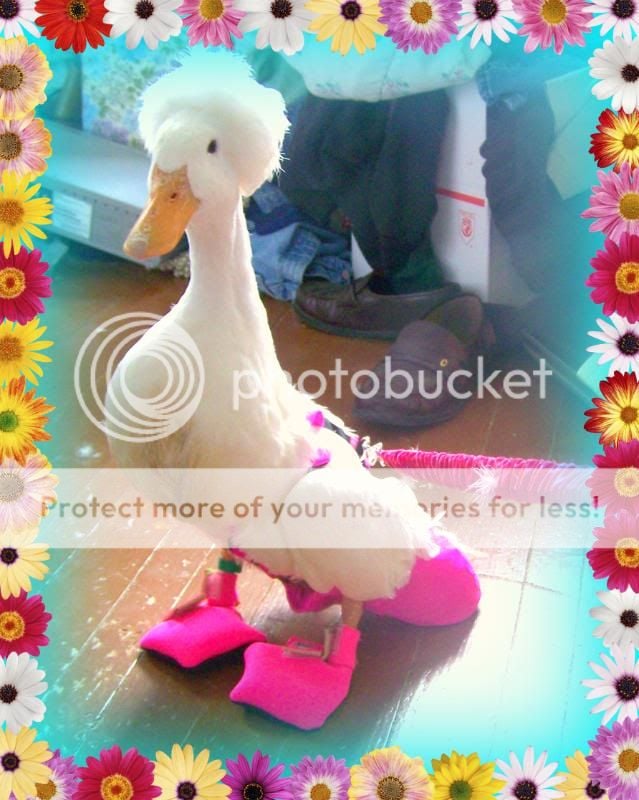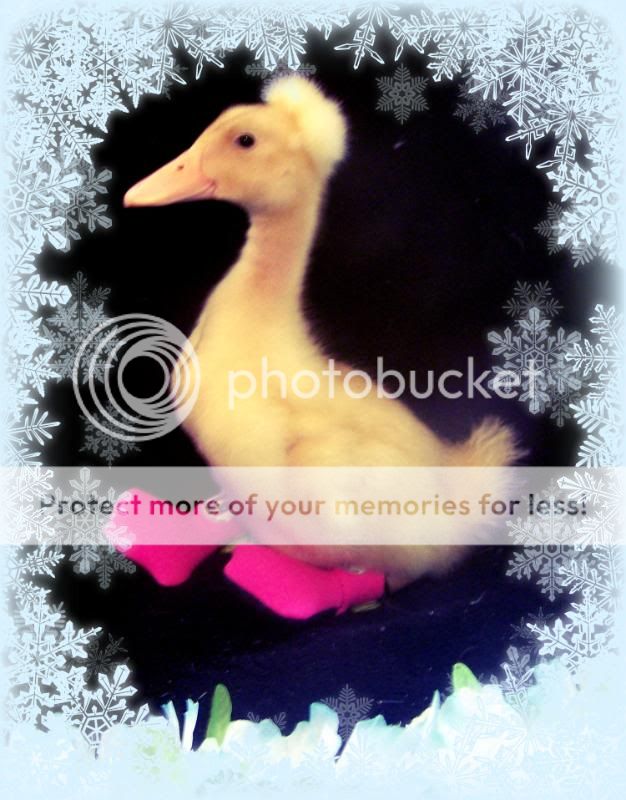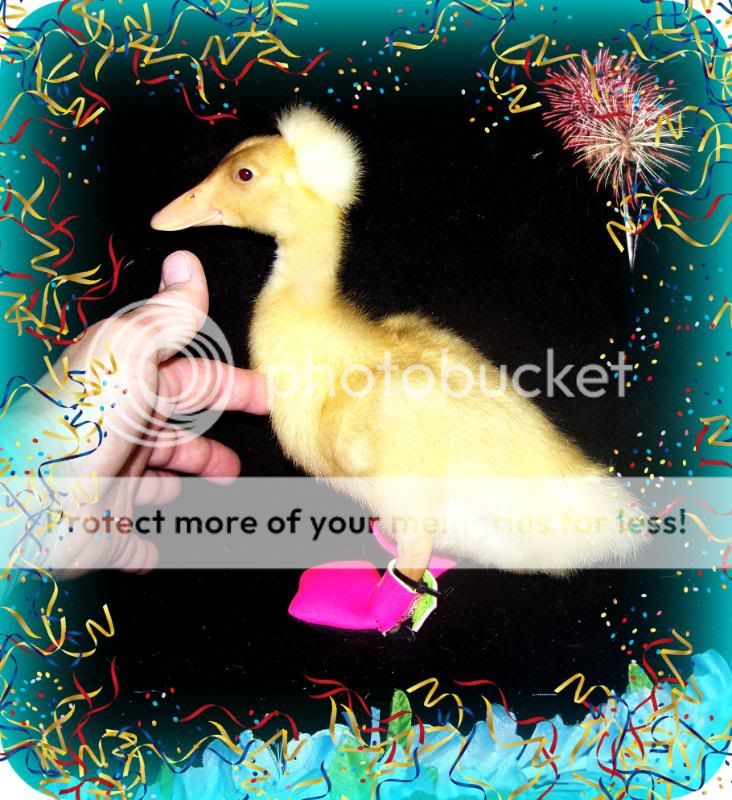This is still a very rough draft of the article I'm writing. I'd love to get feedback from all of you on what you like, what is unclear, and what could use more explaining. I'm sure there's plenty of typos, spelling errors, and grammar mistakes too - feel free to point them out also.
Sorry about the lack of formatting, I didn't want to spend too much time formatting just for this thread.
Click here for the nicely formatted version
Duck Health - Bumblefoot
Disclaimer: I am not a veterinarian nor do I have any formal veterinary education. Always consult your avian vet to diagnose and treat any illnesses for your birds. This page is provided for informational purposes only, not treatment advice. We make no guarantee on the usefulness or accuracy of any information provided. I do have a degree in microbiology which makes me qualified to research and discuss infectious diseases but does not make me an expert on the subject by any professional standards.
What is bumblefoot? What causes it?
Bumblefoot is a bacterial infection of the foot in birds. The bacteria causing the infection is usually Staphylococcus aureus (S aureus or commonly known as staph bacteria)- a very common bacteria found in nearly all of the places you encounter on a daily basis. Odds are you're carrying Staphylococcus aureus on your body right now - most likely in your nose. If you've ever had yellow mucus, it was S. aureus that made it that color. (The species name, aureus, means "golden" and was chosen due to the distinctive color of the bacteria.)
Common illnesses caused by S aureus in humans include skin infections, impetigo (severe skin infections), acute infective endocarditis (severe heart infection), and toxic shock syndrome ("tampon infection"). In plain English: it's a nasty bacteria with lots of dirty tricks up its sleeve.
Although most people carry S. aureus on their skin and mucus membranes (including mouth, nasal, throat, lower intestines, or vagina), it usually does not cause illness without the help of another factor such as open wounds, depressed immune systems, or a breeding ground safe from the immune system (old bandages, dirt in wounds, tampons, etc.).
As is the case for humans, ducks generally do not get staph infections from mere exposure. Cases of bumblefoot are usually preceded by a cut or abrasion on the foot of the duck. Once S aureus gets into an open wound, infection can set in and lead to bumblefoot. However, simply having a wound exposed to staph will not necessarily cause an infection.
Is bumblefoot fatal?
Bumblefoot has the potential to be fatal. Some birds will be able to fight off the infection without any intervention. In some cases, the infection may spread to the rest of the body and cause death. There is no way to tell whether or not a particular infection will go away or lead to death, so it is always recommended to treat the infection.
A simple skin infection due to staph in humans is similar. Most of the time your immune system will be able to fight it off without a problem but in some cases it can lead to death in a matter of days.
How do I know if my duck has bumblefoot?
Two telltale signs of bumblefoot are scabs and localized swelling. Minor cases may be difficult to confirm as swelling may just be callouses developing on the duck's feet. Callouses are perfectly normal and do not require any treatment. Scabs also do not necessarily imply bumblefoot either. It may just be normal healing of a wound. As with all illnesses, consult your avian vet for proper diagnosis and treatment.
Behavioral symptoms include favoring the foot, increased sitting, loss of appetite, and hiding.
[Picture of an advanced case of bumblefoot]
[Picture of a healed foot that had bumblefoot]
[Picture of normal foot]
How do I prevent bumblefoot?
Efforts at preventing bumblefoot should focus on:
1. Preventing foot injuries
2. Reducing exposure to Staphylococcus aureus
Preventing injuries
Preventing foot injuries should begin by examining the ground your duck walks on. Sharp gravel or rocks, wood chips, pine needles, rough concrete or asphalt, wires or metal fencing for flooring, and even low quality wood shavings can cause cuts or abrasions on your ducks feet.
Qualities of bad surfaces:
- Sharp edges or points e.g. gravel chips, pine needles, wood chips
- Hard surfaces that do not reduce impact e.g. concrete
- Rough surface e.g. rough concrete
- Surfaces that get very hot under the sun e.g. asphalt
- Surfaces that put a lot of pressure on a small area e.g. wire mesh
A good rule of thumb is "if you wouldn't jog barefoot on it, it's probably not a good surface for ducks"
If your duck walks on these or any other questionable surfaces, you should consider:
- Prevent them from walking on the surface. Example - if your ducks regularly walk on an asphalt driveway, you may want to build a fence or other barricade to prevent them from walking on it.
- Remove and replace the surface. Example - if there are sharp wood chips in their run, you can remove it and replace it with something safer like pea gravel (small and smooth gravel) or mulch.
- Cover the surface. Example - if their house has a wire floor to allow for better drainage, you can put a thick layer of straw or soft wood shavings over the wire to ensure they are walking on a soft surface.
- Protect the feet of your duck with bandages or shoes.
Obviously, it is not always possible to get rid of all hazardous surfaces. As long as the majority of their available space is safe, they should fare well.
Reducing exposure to bacteria
This is a task you should be doing already - cleaning your ducks' living areas. Not only does it reduce the risk of bumblefoot, but it reduces the risk of other diseases and helps with any smell problems. Basic cleaning taks should include:
- Shoveling or burying their feces. It should come to no surprise to you that feces is concentrated in bacteria. While removal is preferred, burying it is better than no intervention. If you bury by adding more bedding, you will still need to remove all of the old bedding once in a while. The smaller their run, the less effective burying will be as the feces will be concentrated in a small area.
- Scrubbing food, water, and bathing containers regularly. Water containers get filthy quickly, scrubbing off the grime and scum will go a long away at reducing the bacteria levels your duck is exposed to.
- Sterilization. An occasional sterilization of your ducks' living quarters will further reduce the risk of bumblefoot and other diseases.
-- Avoid the use of harsh chemicals such as bleach or ammonia unless you can ensure that the chemicals are completely washed away before you expose your ducks to the cleaned areas
-- Animal safe disinfectants such as "Chlorox Anywhere" can be used. Follow the instructions provided by the manufacturer. While I use this product, I only use it sparingly as it is more expensive and no more effective than the following disinfectants.
-- Vinegar is a safe and effective disinfectant. Get plain white vinegar from the grocery store and put it in a spray bottle (buy a new one - don't reuse ones that had other chemicals in it as the vapors form mixing vinegar with cleaners can be toxic to you and your ducks). Misting the area with vinegar will kill most bacteria
-- Hydrogen peroxide is also safe if you let it sit for several minutes before coming in contact with it. Pour as much as you need into a spray bottle (again, it is important to not reuse spray bottles that were used for anything other than peroxide) and spray down the area. Hydrogen peroxide is sensitive to light so store it in the brown bottle it comes in, not the spray bottle.
-- Vinegar and hydrogen peroxide. DO NOT MIX THESE IN THE SAME CONTAINER. That will create peracetic acid which can be harmful to you and your ducks when concentrated in a bottle. However, if you spray first with vinegar, then peroxide and finally rinse with water, then you will kill more bacteria than you would with vinegar or peroxide alone.
- Protecting their feet. Ducks with foot injuries or a history of bumblefoot (current or recovered) should protect their feet from both injury and exposure to bacteria. We recommend wrapping the ducks feet with bandages or wearing duck shoes.
How do I treat bumblefoot?
Unless you have experience with bumblefoot and access to the correct antibiotics, I strongly urge you to contact your avian vet to treat any suspected cases of bumblefoot.
Removing the bumble (abscess)
Once bumblefoot advances beyond the initial infection, an abscess will form just beneath the skin. A collection of pus will form a cheese-like plug that will need to be removed. This is done by cutting open the bumble and squeezing out the infected pus. The wound will need to be be cleaned and dressed daily until the foot fully heals.
[links to sites showing removal of the abscess]
Treating the infection
Treatment of the infection requires antibiotics. Like most skin infections, a combination of oral and topical antibiotics is the most effective treatment. Baytril is often the antibiotic of choice for both topical and oral medication.
Oral antibiotics serves two purposes. 1) Kill the bacteria at the wound site and 2) kill any bacteria that may have spread to the rest of the body (systemic infection). A systemic infection is extremely serious and will quickly lead to the death of your duck if not treated. Signs of a systemic infection include (but are not limited to) swelling above the wound site, difficulty breathing, and loss of appetite. Oral antibiotics are usually administered in either pill or liquid form. Feeding the antibiotics to your duck usually requires physically inserting the medicine directly into the duck's crop (most effective) or hiding the medicine in their food (less effective).
Topical antibiotics only treat the wound site and will not help your duck if a systemic infection has occurred. However, topical antibiotics should be used in conjunction with oral antibiotics to reduce the risk of new infections at the wound site and speed up the healing process. Your vet may be able to provide a topical antibiotic that is more easily absorbed into the skin than over-the-counter antibiotic ointments. The more efficient topical solutions contain dimethyl sulfoxide (DMSO) which improves absorption of the antibiotic.
Additional treatments
The following can be effective treatments for bumblefoot infections:
- Wearing bandages or shoes to protect the feet from further injury and keep the wound clean.
- Soaking feet in a povidone-iodine and epsom salt solution
- Using over-the-counter antibiotic ointments such as Neosporin. Take care to avoid any ointment or cream that contains pain killers with names ending in "-caine" as these are believed to be toxic to ducks.
- Using corn cushions around the bumbles. This keeps the duck from putting pressure directly on the infection.
- Soaking the feet in Tricide-Neo (an antibiotic solution for fish).
- Using hemorrhoid cream on the healed foot (reportedly toughens the skin to help prevent new injuries)
Case Study 1 - Ming Mei
Our chocolate runner duck, Ming Mei, developed bumblefoot. Nettie determined that the cause of the initial wound on the foot was likely due to low quality wood shavings. Treatment included antibiotics (oral - pills) and soaking the feet in an iodine and epsom salt solution. The feet were bandaged at least daily until full recovery. During this initial bout with bumblefoot, Nettie invented the duck shoe which made bandaging much easier as well as provide cushioning on any surface Ming Mei would walk on.
Several months later, Ming Mei developed bumblefoot on the same spot on her foot. Consulting with our vet we learned that there is often permanent swelling of the feet at the site of a healed staph infection. Due to the permanent swelling, this area receives more pressure than it normally would and is more likely to get injured again. Our vet recommended that we use only soft bedding and ensure the layer is at least one inch thick to reduce any impact.
Treatment required oral antibiotics (baytril in a liquid solution), oral pain killer / anti-inflammatory (meloxicam), a topical antibiotic (baytril in a DMSO solution) with a pain killer (metacam), soaking the feet in iodine and epsom sale solution, and daily bandaging of the feet. The infection was caught early and did not require lancing the bumble. Ming Mei recovered quickly and hasn't had any problems since.
Sorry about the lack of formatting, I didn't want to spend too much time formatting just for this thread.
Click here for the nicely formatted version
Duck Health - Bumblefoot
Disclaimer: I am not a veterinarian nor do I have any formal veterinary education. Always consult your avian vet to diagnose and treat any illnesses for your birds. This page is provided for informational purposes only, not treatment advice. We make no guarantee on the usefulness or accuracy of any information provided. I do have a degree in microbiology which makes me qualified to research and discuss infectious diseases but does not make me an expert on the subject by any professional standards.
What is bumblefoot? What causes it?
Bumblefoot is a bacterial infection of the foot in birds. The bacteria causing the infection is usually Staphylococcus aureus (S aureus or commonly known as staph bacteria)- a very common bacteria found in nearly all of the places you encounter on a daily basis. Odds are you're carrying Staphylococcus aureus on your body right now - most likely in your nose. If you've ever had yellow mucus, it was S. aureus that made it that color. (The species name, aureus, means "golden" and was chosen due to the distinctive color of the bacteria.)
Common illnesses caused by S aureus in humans include skin infections, impetigo (severe skin infections), acute infective endocarditis (severe heart infection), and toxic shock syndrome ("tampon infection"). In plain English: it's a nasty bacteria with lots of dirty tricks up its sleeve.
Although most people carry S. aureus on their skin and mucus membranes (including mouth, nasal, throat, lower intestines, or vagina), it usually does not cause illness without the help of another factor such as open wounds, depressed immune systems, or a breeding ground safe from the immune system (old bandages, dirt in wounds, tampons, etc.).
As is the case for humans, ducks generally do not get staph infections from mere exposure. Cases of bumblefoot are usually preceded by a cut or abrasion on the foot of the duck. Once S aureus gets into an open wound, infection can set in and lead to bumblefoot. However, simply having a wound exposed to staph will not necessarily cause an infection.
Is bumblefoot fatal?
Bumblefoot has the potential to be fatal. Some birds will be able to fight off the infection without any intervention. In some cases, the infection may spread to the rest of the body and cause death. There is no way to tell whether or not a particular infection will go away or lead to death, so it is always recommended to treat the infection.
A simple skin infection due to staph in humans is similar. Most of the time your immune system will be able to fight it off without a problem but in some cases it can lead to death in a matter of days.
How do I know if my duck has bumblefoot?
Two telltale signs of bumblefoot are scabs and localized swelling. Minor cases may be difficult to confirm as swelling may just be callouses developing on the duck's feet. Callouses are perfectly normal and do not require any treatment. Scabs also do not necessarily imply bumblefoot either. It may just be normal healing of a wound. As with all illnesses, consult your avian vet for proper diagnosis and treatment.
Behavioral symptoms include favoring the foot, increased sitting, loss of appetite, and hiding.
[Picture of an advanced case of bumblefoot]
[Picture of a healed foot that had bumblefoot]
[Picture of normal foot]
How do I prevent bumblefoot?
Efforts at preventing bumblefoot should focus on:
1. Preventing foot injuries
2. Reducing exposure to Staphylococcus aureus
Preventing injuries
Preventing foot injuries should begin by examining the ground your duck walks on. Sharp gravel or rocks, wood chips, pine needles, rough concrete or asphalt, wires or metal fencing for flooring, and even low quality wood shavings can cause cuts or abrasions on your ducks feet.
Qualities of bad surfaces:
- Sharp edges or points e.g. gravel chips, pine needles, wood chips
- Hard surfaces that do not reduce impact e.g. concrete
- Rough surface e.g. rough concrete
- Surfaces that get very hot under the sun e.g. asphalt
- Surfaces that put a lot of pressure on a small area e.g. wire mesh
A good rule of thumb is "if you wouldn't jog barefoot on it, it's probably not a good surface for ducks"
If your duck walks on these or any other questionable surfaces, you should consider:
- Prevent them from walking on the surface. Example - if your ducks regularly walk on an asphalt driveway, you may want to build a fence or other barricade to prevent them from walking on it.
- Remove and replace the surface. Example - if there are sharp wood chips in their run, you can remove it and replace it with something safer like pea gravel (small and smooth gravel) or mulch.
- Cover the surface. Example - if their house has a wire floor to allow for better drainage, you can put a thick layer of straw or soft wood shavings over the wire to ensure they are walking on a soft surface.
- Protect the feet of your duck with bandages or shoes.
Obviously, it is not always possible to get rid of all hazardous surfaces. As long as the majority of their available space is safe, they should fare well.
Reducing exposure to bacteria
This is a task you should be doing already - cleaning your ducks' living areas. Not only does it reduce the risk of bumblefoot, but it reduces the risk of other diseases and helps with any smell problems. Basic cleaning taks should include:
- Shoveling or burying their feces. It should come to no surprise to you that feces is concentrated in bacteria. While removal is preferred, burying it is better than no intervention. If you bury by adding more bedding, you will still need to remove all of the old bedding once in a while. The smaller their run, the less effective burying will be as the feces will be concentrated in a small area.
- Scrubbing food, water, and bathing containers regularly. Water containers get filthy quickly, scrubbing off the grime and scum will go a long away at reducing the bacteria levels your duck is exposed to.
- Sterilization. An occasional sterilization of your ducks' living quarters will further reduce the risk of bumblefoot and other diseases.
-- Avoid the use of harsh chemicals such as bleach or ammonia unless you can ensure that the chemicals are completely washed away before you expose your ducks to the cleaned areas
-- Animal safe disinfectants such as "Chlorox Anywhere" can be used. Follow the instructions provided by the manufacturer. While I use this product, I only use it sparingly as it is more expensive and no more effective than the following disinfectants.
-- Vinegar is a safe and effective disinfectant. Get plain white vinegar from the grocery store and put it in a spray bottle (buy a new one - don't reuse ones that had other chemicals in it as the vapors form mixing vinegar with cleaners can be toxic to you and your ducks). Misting the area with vinegar will kill most bacteria
-- Hydrogen peroxide is also safe if you let it sit for several minutes before coming in contact with it. Pour as much as you need into a spray bottle (again, it is important to not reuse spray bottles that were used for anything other than peroxide) and spray down the area. Hydrogen peroxide is sensitive to light so store it in the brown bottle it comes in, not the spray bottle.
-- Vinegar and hydrogen peroxide. DO NOT MIX THESE IN THE SAME CONTAINER. That will create peracetic acid which can be harmful to you and your ducks when concentrated in a bottle. However, if you spray first with vinegar, then peroxide and finally rinse with water, then you will kill more bacteria than you would with vinegar or peroxide alone.
- Protecting their feet. Ducks with foot injuries or a history of bumblefoot (current or recovered) should protect their feet from both injury and exposure to bacteria. We recommend wrapping the ducks feet with bandages or wearing duck shoes.
How do I treat bumblefoot?
Unless you have experience with bumblefoot and access to the correct antibiotics, I strongly urge you to contact your avian vet to treat any suspected cases of bumblefoot.
Removing the bumble (abscess)
Once bumblefoot advances beyond the initial infection, an abscess will form just beneath the skin. A collection of pus will form a cheese-like plug that will need to be removed. This is done by cutting open the bumble and squeezing out the infected pus. The wound will need to be be cleaned and dressed daily until the foot fully heals.
[links to sites showing removal of the abscess]
Treating the infection
Treatment of the infection requires antibiotics. Like most skin infections, a combination of oral and topical antibiotics is the most effective treatment. Baytril is often the antibiotic of choice for both topical and oral medication.
Oral antibiotics serves two purposes. 1) Kill the bacteria at the wound site and 2) kill any bacteria that may have spread to the rest of the body (systemic infection). A systemic infection is extremely serious and will quickly lead to the death of your duck if not treated. Signs of a systemic infection include (but are not limited to) swelling above the wound site, difficulty breathing, and loss of appetite. Oral antibiotics are usually administered in either pill or liquid form. Feeding the antibiotics to your duck usually requires physically inserting the medicine directly into the duck's crop (most effective) or hiding the medicine in their food (less effective).
Topical antibiotics only treat the wound site and will not help your duck if a systemic infection has occurred. However, topical antibiotics should be used in conjunction with oral antibiotics to reduce the risk of new infections at the wound site and speed up the healing process. Your vet may be able to provide a topical antibiotic that is more easily absorbed into the skin than over-the-counter antibiotic ointments. The more efficient topical solutions contain dimethyl sulfoxide (DMSO) which improves absorption of the antibiotic.
Additional treatments
The following can be effective treatments for bumblefoot infections:
- Wearing bandages or shoes to protect the feet from further injury and keep the wound clean.
- Soaking feet in a povidone-iodine and epsom salt solution
- Using over-the-counter antibiotic ointments such as Neosporin. Take care to avoid any ointment or cream that contains pain killers with names ending in "-caine" as these are believed to be toxic to ducks.
- Using corn cushions around the bumbles. This keeps the duck from putting pressure directly on the infection.
- Soaking the feet in Tricide-Neo (an antibiotic solution for fish).
- Using hemorrhoid cream on the healed foot (reportedly toughens the skin to help prevent new injuries)
Case Study 1 - Ming Mei
Our chocolate runner duck, Ming Mei, developed bumblefoot. Nettie determined that the cause of the initial wound on the foot was likely due to low quality wood shavings. Treatment included antibiotics (oral - pills) and soaking the feet in an iodine and epsom salt solution. The feet were bandaged at least daily until full recovery. During this initial bout with bumblefoot, Nettie invented the duck shoe which made bandaging much easier as well as provide cushioning on any surface Ming Mei would walk on.
Several months later, Ming Mei developed bumblefoot on the same spot on her foot. Consulting with our vet we learned that there is often permanent swelling of the feet at the site of a healed staph infection. Due to the permanent swelling, this area receives more pressure than it normally would and is more likely to get injured again. Our vet recommended that we use only soft bedding and ensure the layer is at least one inch thick to reduce any impact.
Treatment required oral antibiotics (baytril in a liquid solution), oral pain killer / anti-inflammatory (meloxicam), a topical antibiotic (baytril in a DMSO solution) with a pain killer (metacam), soaking the feet in iodine and epsom sale solution, and daily bandaging of the feet. The infection was caught early and did not require lancing the bumble. Ming Mei recovered quickly and hasn't had any problems since.





